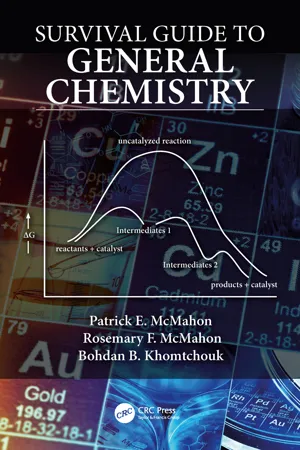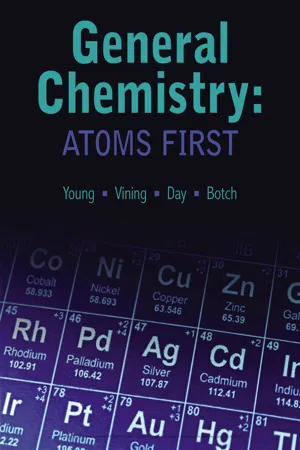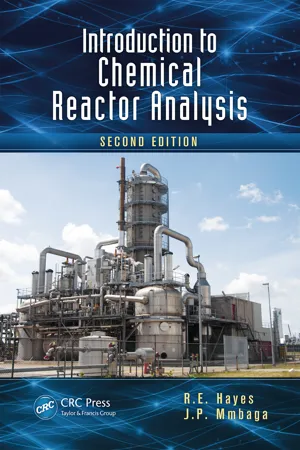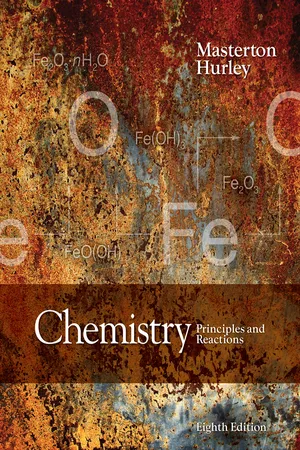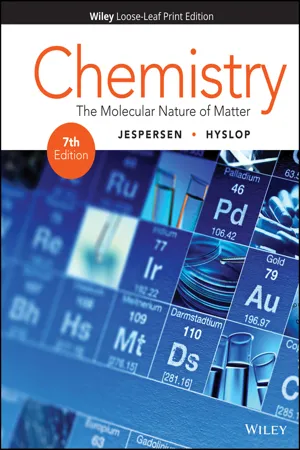Chemistry
Calculating Enthalpy Change
Calculating enthalpy change involves determining the heat energy exchanged in a chemical reaction at constant pressure. This can be done using the equation ΔH = q / n, where ΔH is the enthalpy change, q is the heat energy, and n is the number of moles involved in the reaction. Enthalpy change is a key concept in understanding the energy changes associated with chemical reactions.
Written by Perlego with AI-assistance
Related key terms
1 of 5
12 Key excerpts on "Calculating Enthalpy Change"
- eBook - PDF
Physical Chemistry
Thermodynamics
- Horia Metiu(Author)
- 2006(Publication Date)
- Taylor & Francis(Publisher)
12 ENTHALPY AND ENERGY CHANGE DURING A THERMODYNAMIC TRANSFORMATION Introduction §1. Why Bother? Why would anyone want to calculate how the enthalpy or the energy changes during a thermodynamic transformation? One reason is heat. As you will see later, the heat exchanged between a system and the environment, during a thermodynamic transformation performed at constant pressure, is equal to the change of enthalpy during that transformation. This is true for any iso-baric transformation, including chemical reactions, electrochemical processes in batteries, etc. The easiest way to calculate the heat exchanged in an isobaric trans-formation is to calculate the change of enthalpy. This will be particularly useful in the next chapter, in which we study heats of reaction. The heat exchanged between a system and the environment during a trans-formation performed at constant volume is equal to the change in energy. 219 220 Change of Enthalpy and Energy Calculating the change of energy is the easiest way of calculating the amount of heat produced in a thermodynamic process. Since reactions are carried out at constant volume less frequently than at constant pressure, I will explain how to calculate energy changes in Supplement 12.1. Knowing that material is useful, but is not required for understanding the rest of the book. We need to fuss over heat because heating and cooling are expensive. When design-ing or running a chemical factory we must know how much heat needs to be produced or removed. Even the simple task of compressing a gas produces heat. If the temperature becomes too high it will ruin the equipment. To prevent this we have to cool it. To determine how much coolant is required, the amount of heat to be removed must be calculated. Industrial equipment is often heated by condensing steam. We need to know how much heat the steam produces when it condenses at given temperature and pres-sure. The steam used in one place in a factory is produced somewhere else. - eBook - ePub
- Patrick E. McMahon, Rosemary McMahon, Bohdan Khomtchouk(Authors)
- 2019(Publication Date)
- CRC Press(Publisher)
19 Thermochemistry CalculationsHeat Capacity and EnthalpyI GENERAL CONCEPTS OF THERMODYNAMICS Thermochemistry is a subset of the science of thermodynamics. Thermodynamics (“thermo” = heat; “dynamics” = motion or work) is the study of the complete energy changes (ΔE) for a chemical or physical system.A system is any physical or chemical process or partial process that can be studied in isolation. A system could be a chemical reaction, a phase change, or a solution formation. There is no restriction to the size of a system as long as all energy changes can be isolated and completely identified. For example, a system could be a complete car; a system could be just the engine; a system could be just one cylinder; a system could be just one drop of oil.The surroundings represent everything that can interact with the system. Once a system has been selected, everything else in the universe is considered the surroundings for measurement of ΔE:system + surroundings = complete universeThe term state refers to a measured parameter describing a system. A change of state refers to any change in one or more parameters describing the system:S t a t e(→i n i t i a l)S t a t e(f i n a l)Example:For a change in the total energy of a system:E( inital )→ E( final )the change of state is measured as.(Δ E)= E(f i n a l)- E( inital )For a change in the total pressure of a system:P( initial )→ P( final )the change of state is measured as.(Δ P)= P(f i n a l)- P(i n i t i a l)For a change in the total volume of a system:E( initial )→ E( final )the change of state is measured asA chemical and physical change can be described by more than one change of state. The combustion of octane in an engine produces a ΔPE, a ΔkE, and a combination of ΔP and ΔV..(Δ V)= V(f i n a l)- V(i n i t i a l) - eBook - PDF
- Paul Flowers, Klaus Theopold, Richard Langley, William R. Robinson(Authors)
- 2015(Publication Date)
- Openstax(Publisher)
5.3 Enthalpy If a chemical change is carried out at constant pressure and the only work done is caused by expansion or contraction, q for the change is called the enthalpy change with the symbol ΔH, or ΔH 298 ° for reactions occurring under standard state conditions. The value of ΔH for a reaction in one direction is equal in magnitude, but opposite in sign, to ΔH for the reaction in the opposite direction, and ΔH is directly proportional to the quantity of reactants and products. Examples of enthalpy changes include enthalpy of combustion, enthalpy of fusion, enthalpy of vaporization, and standard enthalpy of formation. The standard enthalpy of formation, ΔH f ° , is the enthalpy change accompanying the formation of 1 mole of a substance from the elements in their most stable states at 1 bar (standard state). Many of the processes are carried out at 298.15 K. If the enthalpies of formation are available for the reactants and products of a reaction, the enthalpy change can be calculated using Hess’s law: If a process can be written as the sum of several stepwise processes, the enthalpy change of the total process equals the sum of the enthalpy changes of the various steps. Exercises 5.1 Energy Basics 1. A burning match and a bonfire may have the same temperature, yet you would not sit around a burning match on a fall evening to stay warm. Why not? 2. Prepare a table identifying several energy transitions that take place during the typical operation of an automobile. 3. Explain the difference between heat capacity and specific heat of a substance. 4. Calculate the heat capacity, in joules and in calories per degree, of the following: (a) 28.4 g of water (b) 1.00 oz of lead 5. Calculate the heat capacity, in joules and in calories per degree, of the following: (a) 45.8 g of nitrogen gas (b) 1.00 pound of aluminum metal 6. - eBook - PDF
- Young, William Vining, Roberta Day, Beatrice Botch(Authors)
- 2017(Publication Date)
- Cengage Learning EMEA(Publisher)
Copyright 2018 Cengage Learning. All Rights Reserved. May not be copied, scanned, or duplicated, in whole or in part. WCN 02-300 Unit 10 Thermochemistry 305 ● Enthalpy is an extensive variable; it is dependent on the amount of substance present (10.4b). ● Bond energy values can be used to calculate the enthalpy change for gas-phase reactions (10.4c). ● Calorimetry is used to determine enthalpy of reaction values (10.4d). ● Constant-pressure (coffee-cup) calorimetry experiments measure enthalpy change for a reaction (10.4d). ● Constant-volume (bomb) calorimetry experiments measure a change in internal energy (10.4e). 10.5 Hess’s Law ● Enthalpy is a state function (10.5a). ● Hess’s Law states that if a reaction can be carried out in a series of steps, the overall enthalpy change for the reaction is the sum of the enthalpy changes for the series of steps (10.5a). 10.6 Standard Heats of Reaction ● Standard enthalpy change is measured under standard conditions, where substances are in their most stable form at bar and a given temperature, and all solutions have a concentration of mol/L (10.6a). ● Standard heat of formation is the enthalpy change for the formation of one mole of a substance from its constituent elements, all in their standard states (10.6a). ● The standard enthalpy of a reaction can be calculated using standard heats of reaction for the reactants and products (10.6b). Key Equations KE 5 ½ mv 2 (10.1) D E system 5 q 1 w (10.2) D E universe 5 0 (10.3) H 5 E 1 PV (10.4) c , specific heat capacity (J > g # °C) 5 q , heat energy absorbed (J) m , mass (g) 3 D T , change in temperature (°C) (10.5) D H ° 5 g (energies of bonds broken) 2 g (energies of bonds formed) (10.6) D H ° rxn 5 g D H f °(products) 2 g D H f °(reactants) (10.7) Copyright 2018 Cengage Learning. All Rights Reserved. May not be copied, scanned, or duplicated, in whole or in part. WCN 02-300 - eBook - PDF
- R.E. Hayes, J.P. Mmbaga(Authors)
- 2012(Publication Date)
- CRC Press(Publisher)
The enthalpy of a system is defined as H U PV = + (2.12) We are concerned with enthalpy changes that occur because of temperature changes, composition changes owing to chemical reaction, and, to a lesser extent, pressure changes. These effects are discussed below. 2.2.2 Energy Change Resulting from Temperature Change: Heat Capacity The enthalpy and internal energy change that occurs because of a temperature change is quantified using the heat capacity. Two heat capacities are used: the constant- volume heat capacity, denoted C V , and the constant-pressure heat capacity, denoted C P . 24 Introduction to Chemical Reactor Analysis The constant-volume heat capacity is defined as the rate of change in internal energy with temperature when the volume of the system is held constant, or C U T V V = ∂ ∂ uni239B uni239D uni239C uni239E uni23A0 uni239F (2.13) The constant-pressure heat capacity is defined as the rate of change in enthalpy with temperature when the pressure of the system is held constant, or C H T P P = ∂ ∂ uni239B uni239D uni239C uni239E uni23A0 uni239F (2.14) These equations are written in partial derivative form to indicate that although the inter-nal energy, U , is usually a function of temperature and density (or specific volume), the heat capacity, C V , has been measured along a path of constant volume. Likewise, C P has been evaluated when the pressure has been held constant. The heat capacity is a strong function of temperature and a weak function of pressure. Usually the heat capacity of a gas is expressed as a polynomial function, such as C a bT cT dT P = + + + 2 3 (2.15) This heat capacity is valid for the ideal gas state, that is, where the ideal gas law is being used (i.e., when the compressibility factor is one). At very high pressures in critical applications, the pressure dependency of heat capacity may be important. - eBook - PDF
Chemistry
The Molecular Nature of Matter
- James E. Brady, Neil D. Jespersen, Alison Hyslop(Authors)
- 2014(Publication Date)
- Wiley(Publisher)
Describe the assumptions and utility of thermochemical equations A balanced chemical equation that includes both the enthalpy change and the physical states of the substances is called a ther- mochemical equation. Coefficients in a thermochemical equa- tion represent mole quantities of reactants and products, so it is reasonable to have fractional coefficients such as 1 2 . Such equa- tions can be added, reversed (reversing also the sign of ∆H ), or multiplied by a constant multiplier (doing the same to ∆H ). If formulas are canceled or added, they must be of substances in identical physical states. The reference conditions for thermochemistry, called stan- dard conditions, are 25 °C and 1 bar of pressure. An enthalpy change measured under these conditions is called the standard enthalpy of reaction or the standard heat of reaction, given the symbol ∆H °. Use Hess's law to determine the enthalpy of a reaction Hess’s law of heat summation is possible because enthalpy is a state function. Values of ∆H ° can be determined by the manipu- lation of any combination of thermochemical equations that add up to the final net equation. The units for ∆H ° are generally joules or kilojoules. An enthalpy diagram provides a graphical description of the enthalpy changes for alternative paths from reactants to products. Determine and use standard heats of formation to solve problems When the enthalpy change is for the complete combustion of one mole of a pure substance under standard conditions in pure oxygen, ∆H ° is called the standard heat of combustion of the compound and is symbolized as ∆H c °. When the enthalpy change is for the formation of one mole of a substance under standard conditions from its elements in their standard states, ∆H ° is called the standard heat of formation of the compound and is symbolized as ∆H f °, (usually in units of kilojoules per mole, kJ mol -1 ). - eBook - PDF
Chemistry
Principles and Reactions
- William Masterton, Cecile Hurley(Authors)
- 2020(Publication Date)
- Cengage Learning EMEA(Publisher)
187 8 ▼ Thermochemistry Chapter Outline 8-1 Principles of Heat Flow 8-2 Measurement of Heat Flow; Calorimetry 8-3 Enthalpy 8-4 Thermochemical Equations 8-5 Enthalpies of Formation 8-6 Bond Enthalpy 8-7 The First Law of Thermodynamics ▼ T his chapter deals with energy and heat, two terms used widely by both the gen-eral public and scientists. Energy, in the vernacular, is equated with pep and vitality. Heat conjures images of blast furnaces and sweltering summer days. Scientifically, these terms have quite different meanings. Energy can be defined as the capacity to do work. Heat is a particular form of energy that is transferred from a body at a high temperature to one at a lower temperature when they are brought into contact with each other. Two centuries ago, heat was believed to be a material fluid (caloric); we still use the phrase “heat flow” to refer to heat transfer or to heat effects in general. Thermochemistry refers to the study of the heat flow that accompanies chemical reactions. Our discussion of this subject will focus on ■ the basic principles of heat flow (Section 8-1). ■ the experimental measurement of the magnitude and direction of heat flow, known as calorimetry (Section 8-2). ■ the concept of enthalpy, H (heat content) and enthalpy change , D H (Section 8-3). ■ the calculation of D H for reactions, using thermochemical equations (Section 8-4) and enthalpies of formation (Section 8-5). ■ heat effects in the breaking and formation of covalent bonds (Section 8-6). ■ the relation between heat and other forms of energy, as expressed by the first law of thermodynamics (Section 8-7). Scala/Art Resource, NY The candle flame gives off heat, melting the candle wax. Wax melting is a phase change from solid to liquid and an endothermic reaction. Some say the world will end in fire, Some say in ice. From what I’ve tasted of desire I hold with those who favor fire. —ROBERT FROST Fire and Ice Copyright 2016 Cengage Learning. - eBook - PDF
- Rose Marie O. Mendoza(Author)
- 2020(Publication Date)
- Arcler Press(Publisher)
If 1 mole of gas is taken to do something, there might be a case that one end up in a new state where for instance the quantity is around 20 L and the temperature is 600 K. For this kind of process, there is a need to take into consideration the change in the state functions. In this scenario, the initial volume Vi, was 10 L and the final volume, Vf, was 20 L. So, the change in volume is given by ΔV=Vf−Vi=20L−10L=10L The primary objective to this belief is that the change in volume has no relation with the particulars on the mystery process that cause to move from the initial state to the final state. The variance in volume will always be the same. That is, for instance, if one starts at a volume of 10 L and ended with a volume of 20 L the difference will always remain same which is +10L. This might seem frightfully obvious. However, if one take into notice about abstract state functions in relation with energy , then it could be more difficult to wrap around the ideas. But it is essential to recognize that the concept is exactly the same. If one has understanding about the initial state as well as the final state, then it is important to calculate the change (regardless of the process by which the change is achieved). 2.7. ENTHALPY Enthalpy (H) is defined as the sum of the internal energy of a system plus the product of pressure as well as volume. The formula is: H = E + PV (2.17) It has been observed that in most chemical systems under study, reactions are carried out under conditions of constant pressure. Under this condition, the change in enthalpy, that is ΔH, is equal to the heat that is exchanged under constant pressure. It has to be noted that, enthalpy cannot be measured directly like the internal energy of a system, and also it is not possible to know the amount of enthalpy that is present in a chemical sample. However, enthalpy change and thus, relative enthalpy, can be evaluated. - eBook - PDF
- Allan Blackman, Steven E. Bottle, Siegbert Schmid, Mauro Mocerino, Uta Wille(Authors)
- 2022(Publication Date)
- Wiley(Publisher)
The opposite is true if the system is compressed. We now rewrite: ΔU = q + w under conditions of constant pressure as shown below, where q p is the heat of reaction at constant pressure. ΔU = q p - pΔV However, this equation is inconvenient as we need to know the value of ΔV if we wish to calculate ΔU. We now define a new thermodynamic function called enthalpy, which has the symbol H, as: H = U + pV Thus, under conditions of constant pressure: ΔH = ΔU + pΔV Substituting ΔU = q p - pΔV into this gives the following equation. ΔH = q p - pΔV + pΔV Therefore, ΔH = q p Thus, the heat of reaction at constant pressure is equal to Δ r H, in the same way that the heat of reaction at constant volume is equal to Δ r U. Like Δ r U, Δ r H is a state function, meaning that the enthalpy change for a reaction depends only on the initial and final states of the system. If the final enthalpy of the system is greater than the initial, the system has absorbed heat from its surroundings, so Δ r H will be positive and the reaction is said to be endothermic. Conversely, if the system has lost heat to the surroundings, the enthalpy of the system has decreased, so Δ r H will be negative and the reaction is said to be exothermic. The difference between the enthalpy change and the internal energy change for a reaction is pΔV. The difference between Δ r U and Δ r H can be very large for reactions that produce or consume gases, because these reactions can have very large volume changes. If a reaction involves only solids and liquids, though, the values of ΔV are tiny, so Δ r U and Δ r H for these reactions are nearly identical. FIGURE 8.12 A coffee cup calorimeter used to measure heats of reaction at constant pressure insulated cover reactants in solution two nested polystyrene cups stirrer thermometer We can obtain values of Δ r H using a very simple constant pressure calorimeter, dubbed the coffee cup calorimeter. - eBook - PDF
Chemistry
The Molecular Nature of Matter
- Neil D. Jespersen, Alison Hyslop(Authors)
- 2014(Publication Date)
- Wiley(Publisher)
Chemists have agreed to a set of standard states to make it easier to report and com- pare heats of reaction. Most thermochemical data are reported for a pressure of 1 bar, or (for substances in aqueous solution) a concentration of 1 M. A temperature of 25 °C (298 K) is often specified as well, although temperature is not part of the definition of standard states in thermochemistry. ∆H °, Enthalpy Change for a Reaction at Standard State The standard heat of reaction, ∆H °, is the value of ∆H for a reaction occurring under standard conditions and involving the actual numbers of moles specified by the coefficients of the equation. To show that ∆H is for standard conditions, a degree sign is added to ∆H to make ∆H ° (pronounced “delta H naught” or “delta H zero”). The units of ∆H ° are really kilojoules/reaction. To illustrate clearly what we mean by ∆H °, let us use the reaction between gaseous nitrogen and hydrogen that produces gaseous ammonia. N 2 ( g) + 3H 2 ( g) h 2NH 3 ( g) ■ Unless we specify otherwise, whenever we write ∆H we mean ∆H for the system, not the surroundings. ■ IUPAC recommends the use of the bar, instead of atmospheres, for standard states. 276 Chapter 6 | Energy and Chemical Change When 1.000 mol of N 2 and 3.000 mol of H 2 react to form 2.000 mol of NH 3 at 25 °C and 1 bar, the reaction releases 92.38 kJ. Hence, for the reaction as given by the preceding chemical equation, ∆H ° = -92.38 kJ. Often the enthalpy change is given immediately after the equation; for example, N 2 ( g) + 3H 2 ( g) h 2NH 3 ( g) ∆H ° = -92.38 kJ An equation that also shows the value of ∆H ° is called a thermochemical equation. It always gives the physical states of the reactants and products, and its ∆H ° value is true only when the coefficients of the reactants and products mean moles of the corresponding sub- stances. The above equation, for example, shows a release of 92.38 kJ if two moles of NH 3 form. - eBook - PDF
- R. Prasad(Author)
- 2016(Publication Date)
- Cambridge University Press(Publisher)
It is required to calculate the change in enthalpy of the reaction. Change in enthalpy DH rea Δ = D D D Q Q RT P V = + ( ) . S-9.4.1 Let us, therefore, calculate D( ) = - + ( ) { } = - 1 1 1 2 1 2 . Substituting this value in Eq. S-9.4.1 one gets, DH rea Δ = D D D Q Q RT P V = + ( ) = - + ¥ + ( ) - ( ) 392 27 8 314 273 25 1 2 . . kJ J Or DH rea Δ = - + ¥ + ( ) - ( ) 392 27 8 314 273 25 1 2 . . kJ J = - - 392 27 1 24 . . kJ kJ Or The change in the standard enthalpy of the reaction = –393.51 kJ 5. Heat of the following reaction, measured in an experiment at constant volume and 25 0 C is –569.18 kJ. 2 2 2 2 2 H g O g H O g ( ) + ( ) Æ ( ) Compute the heat for the formation of H 2 O(g) Application of Thermodynamics to Chemical Reactions 375 Solution: Since the experiment is done at constant volume and at 25 ° C (= 298 K), the measured heat is DQ V at 298 K. We first calculate DQ P at 298 K for the raction using the relation DQ P = DQ V + RTD( ) = –569.18 kJ + 8.314 × 298 × [2 – (2 + 1)]J – 569.18 kJ – 2.48 kJ = –571.18 kJ We are required to find the heat of formation of H 2 O(g). In the given reaction two moles of H 2 O (g) are formed. Therefore, the heat of formation of one mole of H 2 O (g) is 1 2 DQ P . Heat of formation of H O g kJ kJ 2 571 18 2 285 59 ( ) = - = - . . 9.8 Hess’s Law Germain Henri Hess, August 8, 1802–December 13, 1850, was Swiss born Russian chemist Since enthalpy is a state function, the change in enthalpy depends only on the initial and the final states of the system and does not depend on the path of reaching the final state from the initial state. Hess used this principle to give his law for chemical reactions. According to Hess’s law the change in standard enthalpy in a given chemical reaction is equal to the sum of the changes in standard enthalpies of all other chemical reactions that add up to the given reaction. - eBook - PDF
- Paul Flowers, Klaus Theopold, Richard Langley, William R. Robinson(Authors)
- 2019(Publication Date)
- Openstax(Publisher)
INTRODUCTION CHAPTER 5 Thermochemistry 5.1 Energy Basics 5.2 Calorimetry 5.3 Enthalpy Chemical reactions, such as those that occur when you light a match, involve changes in energy as well as matter. Societies at all levels of development could not function without the energy released by chemical reactions. In 2012, about 85% of US energy consumption came from the combustion of petroleum products, coal, wood, and garbage. We use this energy to produce electricity (38%); to transport food, raw materials, manufactured goods, and people (27%); for industrial production (21%); and to heat and power our homes and businesses (10%). 1 While these combustion reactions help us meet our essential energy needs, they are also recognized by the majority of the scientific community as a major contributor to global climate change. Useful forms of energy are also available from a variety of chemical reactions other than combustion. For example, the energy produced by the batteries in a cell phone, car, or flashlight results from chemical reactions. This chapter introduces many of the basic ideas necessary to explore the relationships between chemical changes and energy, with a focus on thermal energy. Figure 5.1 Sliding a match head along a rough surface initiates a combustion reaction that produces energy in the form of heat and light. (credit: modification of work by Laszlo Ilyes) CHAPTER OUTLINE 1 US Energy Information Administration, Primary Energy Consumption by Source and Sector, 2012, http://www.eia.gov/totalenergy/ data/monthly/pdf/flow/css_2012_energy.pdf. Data derived from US Energy Information Administration, Monthly Energy Review (January 2014).
Index pages curate the most relevant extracts from our library of academic textbooks. They’ve been created using an in-house natural language model (NLM), each adding context and meaning to key research topics.

